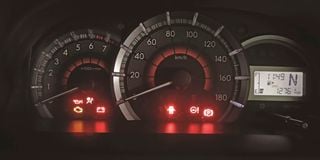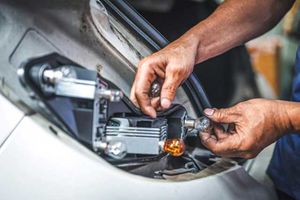
The “Airbags” warning light on my dashboard sometimes flickers or comes on fully while I am driving. What could be causing this and is it dangerous?
Diana.
The only danger is that in the event of an accident your airbags might not work properly. That is definitely worth checking and fixing, the sooner the better. But remember that airbags are inflated by an “explosive” chemical charge, so do not try to repair them yourself.
Get the job done by a specialist with exactly the right parts, diagnostic and resetting equipment, tools and know-how. If you do not know an independent specialist with these competencies, start with the main agents for your make of car. They dare not get it wrong, or the manufacturer whose global reputation may be seriously damaged will come down on their franchise like a ton of bricks.
There are several possible reasons for a flickering warning light, ranging from a faulty connection in the light itself to a worn “coil spring” connector in the steering wheel, a depleted mini-battery pack, a sensor malfunction, a “wet” control module (under the front seats), and so on. There are several computerized processes involved as well as stuff designed to go bang!
It took half-a-century for the first patented idea of airbags to become a fitting in cars, and another half-a-century for them to be refined to their current status and used in almost all makes and models. They are now in their third generation of design, and have evolved from one or two frontal airbags to up to a dozen in some vehicles, including bags that protect pedestrians outside the car…plus all sorts of other applications, such as the vests of Moto GP riders!
The first big technical improvement came in 1967 (a better crash detection system and inflation in 30 milliseconds). That’s why they go off like a bomb. There are probably no airbags in Kenya dated earlier than that, but we do have a high proportion of cars built before the next major technical step dates of 2000 and 2010 which made bags more numerous and even more effective – especially if the bonnet of a car went underneath the back of a truck and the first impact was with the windscreen pillars.
The more modern versions are triggered by decelerative force, wherever the impact occurs, and their inflation and venting is variable according the force involved.
A minor problem that can be a major nuisance

My windscreen washers have stopped working. What could be wrong and how should I check? What are the chances of being able to fix them myself? I am not an engineer, but also not a complete nitwit.
John L.
The fault will be something quite small, but the consequences of not being able to clearly see where you are going can be more serious.
The most likely fault is blocked spray nozzles which can be cleared with a thin but very stiff needle (pins are often too thick or too bendy. The pins that comes with tubes of super glue work well).
But first check that there is plenty of water in the washer bottle and the electric spray pump is working. Stand near the washer bottle while a helper turns on the ignition and presses the washer switch. You should hear the washer pump hum.
If there is a sound and plenty of water move on to the needle. If the sprayers still do not work, check the rest of the water supply line for breaks, leaks or clogging. The pipe is often in sections. These can be tested one by one, starting at the washer pump end and progressively reconnecting the subsequent sections.
If there is no sound from the pump, check that the pump’s fuse has not blown (its location will usually be marked on or inside the fuse box lid. If not, pull the fuses out all one-by one to see if one is visually faulty).
If all the fuses are okay but the pump still does not operate, then check the other electrical connections to the pump are clean and tight and that the wires feeding them are intact.
If there are no apparent problems and no humming sound, then the pump itself will need to be replaced.
Washers usually work well enough with plain water. There are commercial additives which can improve cleaning if conditions and the environment cause lots of squashed bugs or greasy particles to blur your screen. A “home-made” alternative is a few drops of washing-up liquid (not too much or the spray will be foamy) and a dash of methylated spirit. Neither recipe will unclog nozzles, but may help to keep them clean.
The primary culprits for clogging are either using dirty water in the washer tank or external dust (at the front when a car has been parked, or at the back after a dusty safari). Good idea to give both a squirt once in a while.
How braking less can slow you down more...

What is “cadence braking”? What does it do, how is it done, what is it for, how and why does it work? ? Is it something we should all learn?
Philippa.
Cadence Braking is an emergency driving technique that optimizes stopping power while also allowing the vehicle to be steered at the same time. It is now rarely used because modern ABS (antilock braking systems) fitted to most cars do the job automatically…and more efficiently than most humans.
When you apply the brakes the pads squeeze the brake discs and slow down the rotation of the wheels. The harder you press the brakes (up to a point) the sooner they will bring the wheels and hence the vehicle to a halt. Slowing the wheels slows the vehicle…as long as the tyres have enough grip on the road.
However, if you press so hard that the wheel rotation stops (the wheels “lock up” because the force restraining them is greater than the tyres’ friction with the road) the vehicle doesn’t stop, too. It skids. That means the wheels have lost traction with the road surface and are simply sliding along the top of it, so, instead of reducing speed sooner, the slowing effect will be reduced.
And if you try to swerve to avoid a collision at that moment, the vehicle will not turn because there is no friction to relay the steering instruction. All available friction is being used up in reducing straight-line speed, and there is none left to relay changes in direction. Even at full lock the vehicle will maintain its original direction. Until…bang!
Positive action
It is human instinct to brake hard in an emergency, and even harder if you are about to hit something. And even harder than that (combined with frantic efforts to swerve) if the wheels lock up and skid.
Very hard initial braking is the right and positive action in an emergency. But if the wheels lock the most effective solution is to reduce pressure on the brakes until the wheels regain traction, which makes braking more effective again and gives grip for some steerage. And then resume pressure until the wheels start to lock again. And so on.
Cadence braking is a technique to learn and practice that (counter-intuitive) reaction.
But the scientific explanation is a “slow motion” version of reality. In practice, it means pressing and releasing the brakes several times in very quick succession…perhaps once every second…with judgement. You are effectively “pumping” the brakes on and off, and steering, in the throes of an imminent prang.
Drivers with the knowledge, aptitude and no small amount of practice can manage that. ABS does the same thing, automatically, many times per second, so the tyres are always on the very brink of locking up but do not, whatever variations there may be in the road-surface friction from one rotation to the next.
But being a human has its advantages and even ABS has its limits, that in some instances can even increase stopping distances – such as on pure ice (where ABS will allow almost no braking force and locked wheels with winter treads might do better) or on very loose/soft surfaces where locking the wheels will dig a wedge of dirt in front of the tyres as an added no-skid decelerant.






